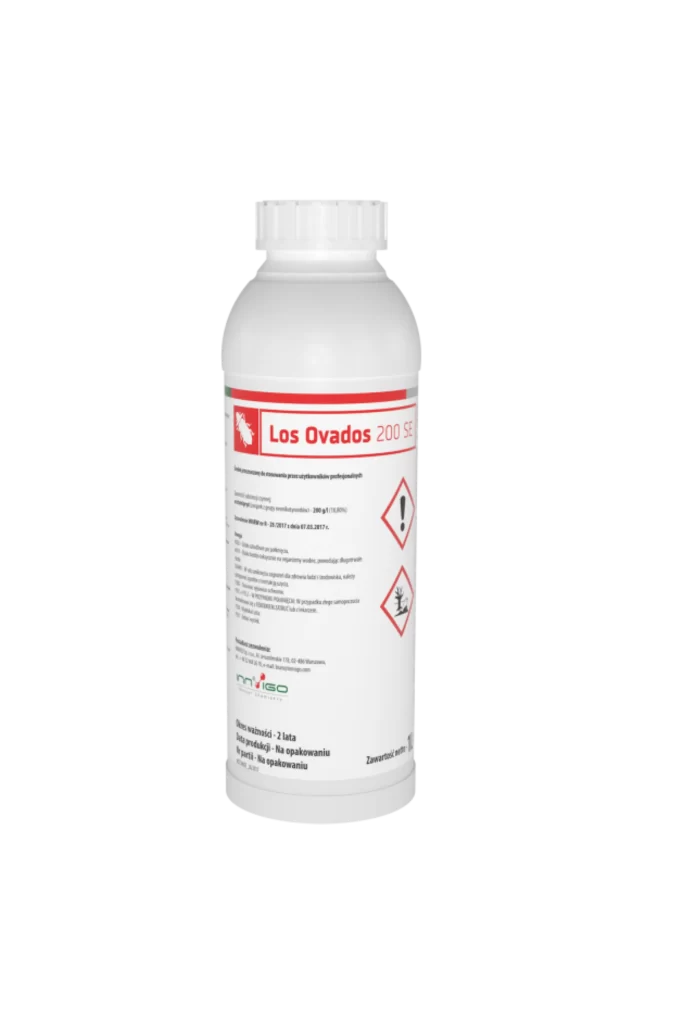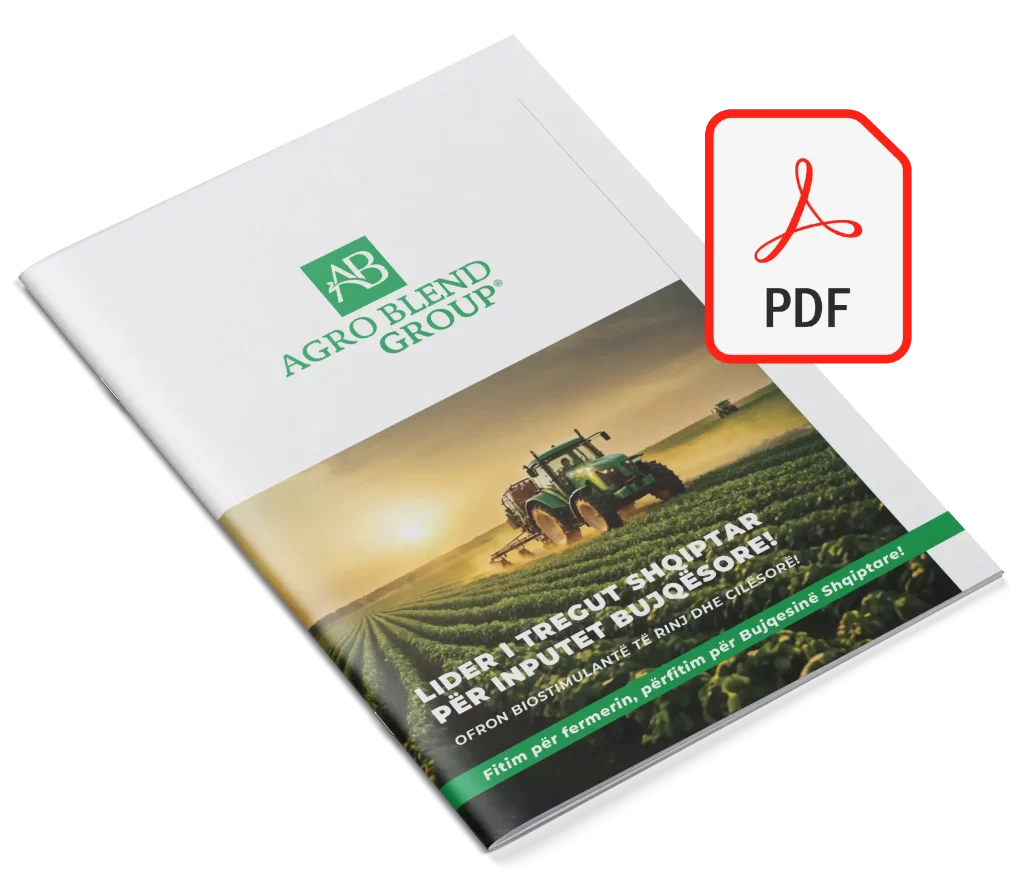
Formulation: Suspended Emulsion (SE)
LOS OVADOS 200 SE is an insecticide with contact and stomach action, aimed at controlling sucking and biting insects. The product has contact, translaminar, and systemic effects on plants. In accordance with the IRAC classification, the active substance, acetamiprid, is classified as group 4A.
Please consult the technical service for advice on specific crops and conditions.
First aid instructions and advice for the doctor:
H302: Harmful if swallowed. In case of swallowing, contact with the respiratory organs and skin may cause the following symptoms: eye irritation, muscle spasms, dyspnea, cyanosis, possible ataxia, bradycardia.
H410: Very toxic to aquatic life with long-lasting effects.
H361d: Suspected of damaging fertility or the unborn child.
In case of contact with skin or mucous membranes, wash thoroughly with plenty of water and soap.
In case of inhalation of the spray solution with respiratory organs, place the affected person in a warm and well-ventilated environment.
In case of poisoning, immediately seek assistance at the nearest hospital, showing the doctor the product label.
If swallowed: Call a poison center or doctor if you feel unwell. Rinse your mouth.
If medical advice is needed, have the container or product label at hand.
No specific antidote is known. Treatment should be symptomatic.
Antidote: None, treated symptomatically.
Note: The product contains the active substance acetamiprid – a neonicotinoid component (insecticides that interact with nicotine acetylcholine receptors (Ach) – IRAC group 4A). To minimize the risk of insect resistance, the following recommendations should be followed: the product should only be used at the recommended doses and periods, the recommended number of treatments per season should not be exceeded, and if additional treatments are necessary, a product with an active ingredient from a different group and with a different mode of action should be used.
Solution preparation: Before starting to prepare the solution, carefully determine the required volume along with the amount of product. When filling the sprayer, follow the sprayer manufacturer’s instructions. In the absence of instructions, add the measured amount of product to the sprayer tank, which should be partially filled with water (with the mixer running). Rinse the empty containers three times with water and pour them into the sprayer tank along with the solution. Add water to the required amount and mix well. After pouring the product into a sprayer tank that does not have a hydraulic mixer, mix the solution mechanically. In case of interruption in spraying, thoroughly mix the solution in the sprayer tank before resuming spraying. Clean the equipment thoroughly after use.
Phytotoxicity: No signs of phytotoxicity are observed at the recommended doses and plants.
Usage Warning: The product should not be used on alkaline soil for the production of winter rapeseed, spring rapeseed, and potatoes. Spraying on insects (especially sucking insects) should be complete, covering all parts of the plant with the spray solution. The product should be used at temperatures below 20°C. At higher temperatures, the treatment should be carried out at the end of the day.
Impact on the Ecosystem:
EUH401: To avoid risks to human health and the environment, follow the usage instructions.
EUH208: Contains 1,2-benzisothiazol-3(2H)-one. May cause an allergic reaction. Do not contaminate water with the product or its packaging. Do not wash equipment near surface waters. Avoid contamination of watercourses from farms and roads. Prevent spills into the environment. During the flowering period of different crops, it is recommended to use the agent outside the bee activity periods. Do not use the product on alkaline soil. Maintain a buffer zone of at least 2-3 meters from residential buildings/inhabitants and third parties during field sprayer application and at least 5 meters during tree sprayer application.
To protect aquatic organisms, it is necessary to establish a buffer zone of 20 meters from water reservoirs and water passageways. To protect other plants and arthropods, maintain an untreated buffer zone of 5 meters from non-agricultural land, or 1 meter from non-agricultural land, simultaneously taking measures to reduce the drift of the spray liquid by 90% during the treatment.
Pre-harvest Interval: All intervals between the last application of the product and the day when the crop is harvested (waiting period):
Potatoes: 7 days
Rapeseed: 39 days
Apples, cherries, sour cherries, walnuts, hazelnuts, pears, plums, nespuls, quinces: 14 days
Tomatoes, peppers, and eggplant in greenhouses: 3 days
Safety Period for Entry: The period between the application of the product and the day when people and animals can enter the treated area (preventive period): 1 day.
Storage Conditions: Keep the plant protection product in its original packaging, at a temperature between 0°C and 30°C.
Potatoes: against the Colorado potato beetle (Leptinotarsa decemlineata). The recommended dose for a single use is 0.1-15 liters/ha, diluted in 200-300 liters of water. Treatment should be carried out when eggs are detected and larvae begin to hatch in large numbers, from the 50% row coverage stage until full flowering (50% of flowers in the first bloom are open) (BBCH 35-65). Use the higher recommended doses in case of a mass outbreak. Apply 1 treatment/season.
Apples and pears: against aphids (Aphis spp., Dysaphis plantaginea). The maximum recommended dose for a single use is 0.125 liters/ha, diluted in 700-750 liters of water. Apply when the first aphid colonies appear. Perform treatment from the end of the flowering stage until fruit reaches 10 mm in size (BBCH 69-71).
Against codling moth (Cydia pomonella): The maximum recommended dose for a single use is 0.2 liters/ha, diluted in 700-750 liters of water. Treat at the beginning of pest flight and mass egg-laying, at the end of the flowering phase, until the fruit diameter reaches 40 mm, as the fruit grows (BBCH 69-74). Apply 1-2 treatments/season, with a 30-day interval.
Cherries, sour cherries: against fruit flies (Rhagoletis cerasi), apply the product when flies appear in large numbers and lay a significant number of eggs. Perform the treatment from when the fruit reaches 90% of its typical size until the beginning of ripening and coloring of the fruit (BBCH 79-81). Against aphids (Aphis spp.), apply when the first aphid colonies appear. Perform the treatment from when the fruit reaches 90% of its typical size until the beginning of ripening and coloring of the fruit (BBCH 79-81). The maximum recommended dose for a single use is 0.125 liters/ha, diluted in 750 liters of water. Apply 1 treatment/season.
Walnuts and hazelnuts: against aphids (Aphis spp.), apply the product from the end of the flowering phase (BBCH≥69). The maximum recommended dose for a single use is 0.2 liters/ha, diluted in 200-750 liters of water. Apply 1-2 treatments/season, with a 30-day interval.
Winter and spring oilseed rapeseed: against Meligethes aeneus, Ceutorhynchus assimilis, Ceutorhynchus quadridens, Dasineura brassicae, Meligethes aeneus, Athalia colibri, Aphis spp. Apply when pests infect the plantation, according to the signal, from the compact flower bud stage (visible single buds, closed in the main bloom) to the full flowering stage of the rapeseed (BBCH 55-65). The higher recommended dose should be used in case of an intensive pest attack in the plantation. Against Ceutorhynchus assimilis, Dasineura brassicae, apply during the flowering phase, from when 20% of the flowers are open until the end of the flowering stage (BBCH 62-69). The higher recommended dose should be used in case of an intensive pest attack in the plantation. The recommended dose for a single use is 0.12-0.25 liters/ha, diluted in 200-300 liters of water. Apply 1 treatment/season.
Plum: against Aphis spp., Hoplocampa spp., Cydia pomonella, Parthenolecanium corni, treat from the end of flowering until fruit ripening (BBCH 69-89). The recommended dose for a single use is 0.125-0.2 liters/ha, diluted in 600-1000 liters of water. Apply 1-2 treatments/season, with a 30-day interval.
Tomato (greenhouse), pepper (greenhouse), eggplant (greenhouse): against Trialeurodes vaporariorum, Thrips tabaci, Frankliniella occidentalis, Phytomyza spp., Aphis spp., Lygus spp., Alticini spp., treat from the first leaf stage to the full color of the fruit (BBCH 11-89). The recommended dose for a single use is 0.24-0.3 liters/ha, diluted in 600-750 liters of water, for a double use 0.12-0.2 liters/ha, diluted in 300-500 liters of water.
Nurseries of decorative plants and forestry nurseries, decorative plants: against Aphis spp., Collembola, Coleophora laricella, use the agent as specified, from the first leaf expansion stage until the end of flowering (BBCH 11-69). The maximum recommended dose for a single use is 0.2 liters/ha, diluted in 250-400 liters of water. Apply 1-2 treatments/season, with a 30-day interval.
Sugar beet, forage beet, red beet: against Bothynoderes punctiventris, Chaetocnema concinna, atomaria linearis, and plant pests, apply the product from the second leaf stage to the ninth leaf stage (BBCH 12–19). The maximum recommended dose for a single use is 0.25 liters/ha, diluted in 300-400 liters of water. Apply 1 treatment/season.
Celery: against pests like Pieris brassicae, Pieris rapae, Autographa gamma, Plutella xylostella, Mamestra brassicae, and other leaf-feeding pests, Euleia heraclei, Chamaepsila rosae, Lygus, Spodoptera exigua, Spodoptera littoralis, and plant pests, apply from the second leaf stage to the ninth leaf stage (BBCH 12-19). The maximum recommended dose for a single use is 0.25 liters/ha, diluted in 300-400 liters of water.
Medlar and quince: against plant pests, use from the end of flowering until the fruit reaches a diameter of 40 mm (BBCH 69–74). The maximum recommended dose for a single use is 0.2 liters/ha, diluted in 750 liters of water.
• P102: Keep out of reach of children.
• P103: Read the label before use.
• P201: Obtain special instructions before use.
• P202: Do not treat until all safety warnings are read and understood.
• P281: Wear protective clothing.
• P405: Store locked up.
• EUH401: To avoid risks to human health and the environment, follow the instructions for use.
| Active Ingredients | |
|---|---|
| Acetamiprid | 200 g/l (18.8%) |
The product should be used alone. If mixed with other formulations, the longest waiting period should be observed. Calibrate sprayers to spray only from a short distance.
Please consult the technical service for additional advice on compatibility.

For a list of all the products & information on their usage.